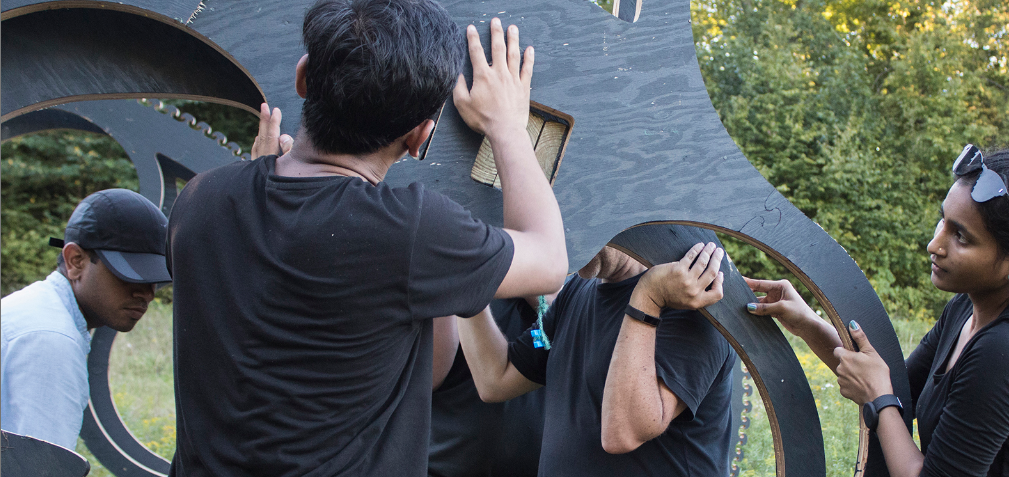
Directed Research (DR) involves a wide spectrum of courses and instructors in the Graduate Architecture and Urban Design (GAUD) department. It is a term to characterize the latent overtones of the work we are doing with students as well as to focus and direct our future efforts toward enhancing discourse, knowledge exchange, and a deep understanding of how architects and design can impact our profession and discipline. The DR initiative is first and foremost an effort to integrate design research across the curricula of all three programs in an appropriate and distinguishable manner specific to the assets and characteristics of the GAUD and Pratt Institute. It is also an effort to characterize existing faculty-driven research projects.
The GAUD is committed to pushing the limits of contemporary design thinking. GAUD DR is architecturally specific, design-oriented, and has a high degree of disciplinary precision; sufficient to engage audiences and disciplines outside of architecture. In the culminating semesters of all three GAUD programs (M.Arch, MS.Arch, and MS.AUD), in our international programs (Rome and Havana), and following several semesters of integrative disciplinarily focused learning, these design studios and elective seminars are engaged in pertinent research at the cutting-edge and near future of both disciplinary and professional praxes. The array of courses is fundamentally extra-disciplinary in character and overseen by a stellar ensemble of full-time and visiting design and theory faculty.
Two broad initiatives guide individual faculty and program-led directed research:
- New Architectural Contexts — an area of research that explores the ways in which architecture activates context; a symptom of 21st century cities as they become increasingly more dense, as they grow inward and accumulate on top of themselves to conserve resources; cultural, economical, and ecological. Shifting the discourse on “architecture and the city” away from the semiological and away from quantitative performance-based design, the focus at the GAUD is understanding architectural context as that which is fundamentally premised on the design of urban qualities.
- The reformulation of architectural praxes that results from this re-centering of context in the discipline is of equal interest. No longer the last step of municipal planning, this strain of investigation examines how architecture is situated as the “early prototype,” re-postulating codes and probing the potentials of a rapidly densifying city and/or its vacuous rural compliment. Demanding the intertwining of architecture, landscape architecture, urban design, interior design, and conservation, and operating at a scale larger than a building yet smaller than the city, New Architectural Contexts pushes to an extreme concepts of architectural alteration and re-origination, challenging conventional notions of adaptive re-use, infill, development, and conservation.
- New Architectural Mediums — an area of research that explores how architectural design can engage multiple senses via the media and mediums that interact with architecture. It centers on architecture as the design of “live experience,” engaging concepts of environmental graphics, material visualization, branding, and object design, among others. Spanning from the inclusion of hydrological, horticultural, luminous, and sonic media to speculating upon the use of media facades, sensory networks, graphics, cinema, op art, and robotics, this strain of research shifts its disciplinary focus from generative and/or representational aspects of architectural media (the processes that lead up to a piece of architecture), to the experiential and qualitative effects of highly mediated architectures.
GAUD DR Guidelines
All courses in the curricular areas undertaking DR follow the below-noted guidelines:
- EXPLOIT MULTI-MODAL DESIGN METHODS: Courses have an extra-disciplinary orientation, including (but not limited to) financial, methodological, technical, artful, philosophical, and/or theoretical perspectives.
- USE DISCIPLINARY PRECISION: These are precise, focused, and rigorous faculty-driven, research-based courses. That research challenges our perspectives of the discipline and our understanding practice.
- FOSTER KNOWLEDGE EXCHANGE: Courses engage other audiences/stake holders directly as participants (in some cases) may be taught in collaboration with (or directly supported by) other Pratt departments and/or private, public, educational, non-profit or governmental organizations.
- CULTIVATE SPECIFIC OUTPUTS: Courses push multi-modal, inter-media outputs, including (but not limited to) complex assemblies in physical models, new formats of writing about and/or theorizing architecture discourse, unique ideas and methods of using architectural media/mediums, and unique ideas and methods of transforming architectural context.